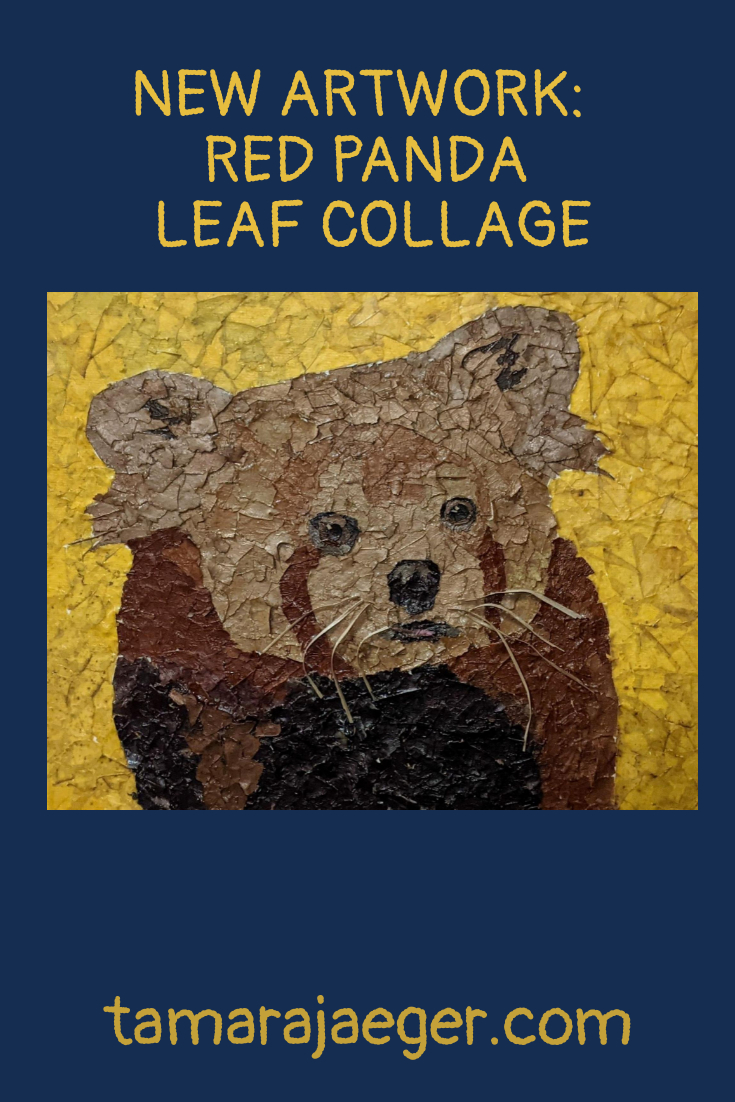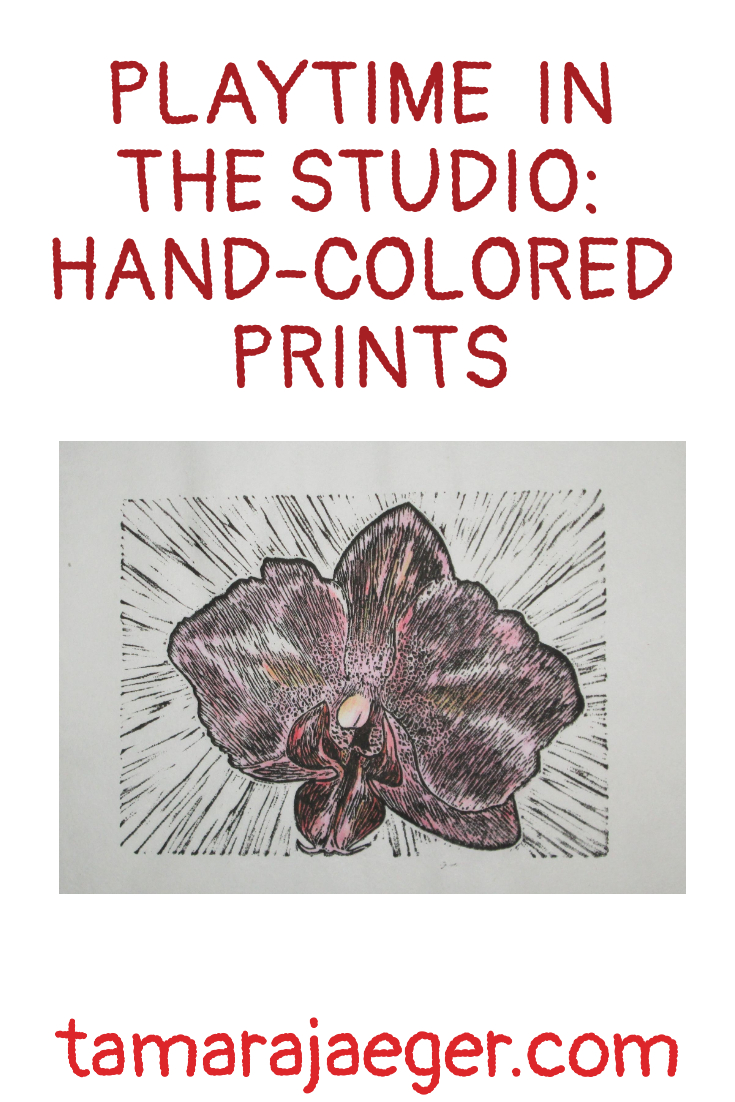Posts in Category: Playtime in the Studio


New Artwork: Red Panda Leaf Collage
Here’s another new piece. It’s actually an experiment. I have No idea how it will hold up over time!
Based on an off-hand comment from a friend about a photo I took of my dog sitting in a patch of leaves, I decided to see if it was possible to create a collage out of leaves! It’s just another material, right? Kind of like the magazines and catalogs I usually use. But different…

Anyway, I created this collage of a Red Panda using just fallen leaves that I collected in my neighborhood. I’m not entirely thrilled with the bright yellow background, but it was kind of at the end of the season, so there weren’t many non-brown colors left to choose from! White is also quite tricky to come by. I settled for a pale tan. It kind of gives the whole piece and ‘aged newspaper’ look that I think I like.

Leaves are definitely a tricky material to work with. When they’re fresh, they’re flexible and easy to tear. The next day, they’re all dried out and crispy and nearly impossible to work with! I may try keeping them in a sealed plastic box or bag to keep them flexible. Possibly in the fridge, so they don’t start to mold. Fresh, ‘green’ leaves are also something I might test out. It’s definitely a material I plan on exploring further.
Since this was a ‘test,’ it’s a little smaller than I usually make my collages and isn’t quite as detailed. I really just wanted to see how well leaves would work for collage and how well it holds up over time. I used an 8” x 10” canvas panel and my go-to “adhesive,” Golden Acrylic Soft Gel Medium. I coated the piece with Winsor & Newton Galeria Acrylic Satin Varnish to help protect the leaves (and hopefully the colors).
What do you think of the result? I’ll keep you posted on how it ages over time.
Want to stay up to date and see more of what I’m working on? Sign up for my mailing list here and get a FREE digital download of an exclusive tiger linocut print. (I promise not to be spammy with my emails—I hate that too!)
* Please note that this post contains affiliate links and any sales made through such links will reward me a small commission – at no extra cost for you.


Playtime in the Studio: Hand Colored Prints
There are always a few prints that just don’t come out well. Maybe the ink is uneven, or the paper slips slightly. For whatever reason, not every print is ‘good enough.’ So, what do you do with the bad prints? You don’t really want to just throw them out, but on the other hand, they’re just taking up space and cluttering up the studio.
I decided to use my ‘junk’ prints to test out a few methods of hand-coloring my prints. Who knows, if it turns out well, it might be a nice alternative to offer, instead of just a single color print.

For a first trial, I tested watercolors and Derwent Inktense pencils to color in some of my passion flower prints. Derwent Inktense pencils are a water-soluble pencil that gives an ink-like intense color once wetted. They’re similar to watercolor pencils, but the colors are more intense.

So, here I have a few examples. I’m not entirely happy with either method, though I think I like the Inktense pencils better—the colors are more vibrant and it’s much easier to control where the color goes compared to using watercolors. Watercolor pencils would probably work similarly as far as control, but the colors would be less intense. I might give that a try at some point.
What do you think? Do you like the watercolors or the Inktense pencils better? Or do you prefer the uncolored version? Let me know your thoughts!
Want to keep updated and see more of what I’m working on? Sign up for my mailing list here and get a totally FREE digital download of a tiger linocut print. (I promise not to be spammy with my emails—I hate that too!)
* Please note that this post contains affiliate links and any sales made through such links will reward me a small commission – at no extra cost for you.


Playtime in the Studio
So, I haven’t actually had a lot of free time to play in my studio lately. Hoping that will change soon; we’ll see.
Several months ago I thought I’d try keeping a gratitude journal. I’ve heard all kinds of good things about them. But I didn’t really feel like straight up journaling. I’ve journaled in the past, and while it’s not quite the same thing, I’ve always found it difficult to keep consistent.
But then I thought, why not make some sort of visual gratitude journal? And so the gratitude tree was born! I liked the idea of creating small pieces that I could add to my tree and watch it ‘grow’ over time.

I have several shapes and paper types of blank ‘leaves’ as well as a number of blank butterfly shapes because, why not? So when I have my things I’m feeling grateful for, I can just select a shape, write out my gratitude, decorate it however I want, and hang it on my ‘tree.’
It’s a fun way to keep reflect on the good things in my life and it serves as a reminder whenever I see my gratitude tree, which is currently hanging on a wall in my studio.

Do you keep a gratitude journal? What has your experience been? Tell me in the comments.
Want to keep updated and see more of what I’m working on? Sign up for my mailing list here and get a totally FREE digital download of a tiger linocut print. (I promise not to be spammy with my emails—I hate that too!)


Playtime in the Studio
I’m sure most artists have stuff they’re working on that isn’t intended to be “real” art. (Or maybe I’m just weird! That’s entirely possible…) New techniques, new mediums, testing out new art supplies. The projects that are done just for fun, or to take a break.
I think that experimenting, exploring, and playing with are important parts of the creative process. It helps to try out new things without any pressure for the resulting artwork to be “good.” That new technique you tried didn’t work so well? That’s okay. You learn and grow from it and the next piece will be better. And it doesn’t matter that it sucked—you’ll still get the bills paid, the dinner cooked, the laundry done… Your “real” artwork is still awesome.
But sometimes your art play leads to something more. Maybe that trial piece turned out really well, maybe it’s a technique that you’ve discovered you Love and it starts to take your art in a new direction. There’s so much you can learn if you take the time to play!
In that vein, I decided to share a few of the small “play” pieces I’ve been working on lately. First, I have a pair of tiny oil pastel paintings on canvas-textured board. They’re 3”x3” so much smaller than I’m used to working. I do like oil pastel, even though I don’t often work with it. I hate the canvas-textured boards for oil pastel though. The texture is too rough and coarse for such a tiny piece—it’s really difficult to get smooth layers of color and fine details. I’ll have to try the boards with a different medium.


I’m thinking of trying to work on some smaller pieces, maybe Artist Trading Card size? Just for the challenge. I tend to make primarily moderately-sized pieces. It’s fun to work really large, but that takes up a Lot of space! Of course, I do actually have a house with a yard and garage now, instead of a tiny apartment, so perhaps I should work on some larger pieces. We’ll see. For now, I’ll work small and see what happens with that.
I also recently tried out Yupo Paper. It’s 100% polypropylene; I’ve never tried painting on plastic “paper” before. It’s definitely a learning experience. The biggest difference I noticed using watercolor are that the water doesn’t soak into the paper. At all. The paper also doesn’t buckle and curl and the paint can be removed from the paper even after it has dried. This can be good or bad, depending on what you were trying to do! I think Yupo
is a product that is worth playing with further, if only to see just how far I can push it. I’m sure it would be an interesting substrate for many other mediums than just watercolor.

What about you? What have you been “playing” with lately? Share in the comments below!
* Please note that this post contains affiliate links and any sales made through such links will reward me a small commission – at no extra cost for you.